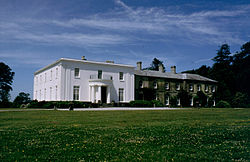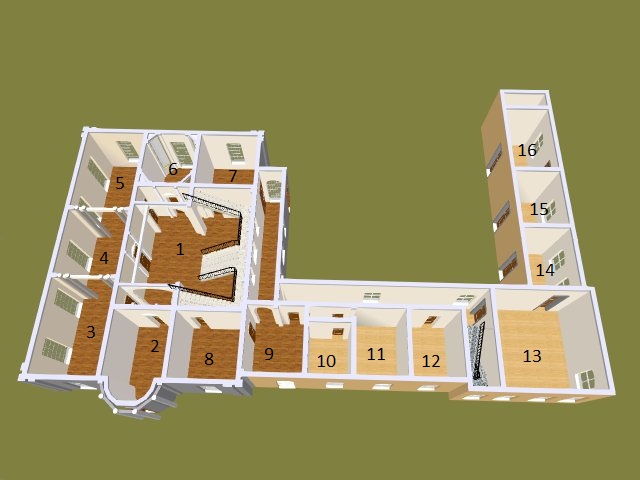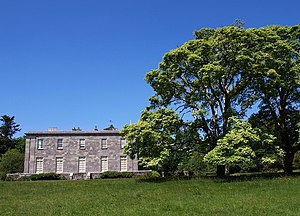Arlington Court
| Arlington Court | |
|
National Trust | |
|---|---|
 Arlington Court | |
| Grid reference: | SS614404 |
| Location: | 51°8’46"N, 3°58’56"W |
| Built 1820-23 | |
| Information | |
| Website: | Arlington Court |
Arlington Court is a neoclassical style country house built 1820-23,[1] in the parish of Arlington in northern Devon, five miles north-east of Barnstaple.
The house stands next to the parish church, St James.
The house was built in 1820 to 1823 for Colonel John Palmer Chichester (1769-1823) to the design of the north Devon architect Thomas Lee, replacing an earlier house completed just thirty years before it was superseded and demolished.
Today, Arlington Court is in the ownership of the National Trust, and is a Grade II* listed building. The park and gardens are Grade II* listed in the National Register of Historic Parks and Gardens.[2]
History
The house was commissioned by Colonel John Palmer Chichester (1769-1823), to replace the estate's earlier Georgian house of about 1790, built on a different site, which was demolished. Colonel Chichester's architect was a local man, Thomas Lee.
Arlington Court was considerably expanded in 1865 by Colonel Chichester's grandson, Sir Alexander Palmer Bruce Chichester, 2nd Baronet (1842-1881). In 1873 according to the Return of Owners of Land, 1873 the Arlington estate comprised about 5,300 acres.[3]
Sir Bruce's unmarried daughter and heiress, Rosalie Chichester (d.1949), donated the mansion to the National Trust, together with 3,500 acres, two years before her death in 1949.
Today, the house, together with the Chichester family's collection of antique furniture and an eclectic collection of family memorabilia, is fully opened to the public.
Architecture

The architecture of the house, a severe neoclassical style, which in many ways resembles the architecture made popular in the early 19th century by Sir John Soane, under whom Arlington's architect Thomas Lee trained.[4] Often mistakenly likened to the slightly more flamboyant Greek Revival architecture, the style confines most ornament to the interior of the house, leaving the symmetrical exterior almost unadorned and chaste, relying only on window and door apertures and shallow recesses and apses and the occasional pilaster to relieve the austerity of the facade; at Arlington, this is seen in the shallow twin pilasters terminating the two principal façades, the lack of either aprons or pediments to the windows and, in place of the near conventional classical entrance portico of the era, is a single-story, semi-circular pillared porch. The simplicity of the design is further accentuated by a low, unpierced parapet concealing the roof-line from view; thus giving the building a low, box-like appearance.
From completion, the house remained largely unaltered until the 1860s, when the house was almost doubled in size by Sir Alexander Bruce Chichester, who added the large domestic wing (rooms 9 to 16 on plan) in which to house the servants and provide the extended domestic offices which were considered necessary during the Victorian era. Following the invention of the bell pull, a convenient device which negated the need for servants to be constantly within calling distance of the main house, servants began to be housed in a designated wing; thus affording their employers greater privacy.
Sir Alexander (a man of extravagant tastes, whose expenditure was to ultimately bring the family to the point of financial ruin[5]) also created the large, central staircase hall (marked 1 on the plan); this was achieved by combining several smaller rooms on the ground and upper floors.[6] The style of the hall, that of a Renaissance courtyard, overlooked by a gallery reached from an imposing staircase was a fashionable country house feature of the time – providing a common assembly area for house-guests and a convenient space to display works of art and curiosities; similar halls can be seen at Highclere Castle, Mentmore Towers and Halton House. Often known as lounge halls, they were usually furnished as with comfortable chairs and sofas and often a grand piano. Contemporary pictures show that this was the case at Arlington too.[7] The hall is dominated by an enormous imperial staircase rising to the gallery above. The stairs are lit by an internal window displaying the various Chichester arms from 1505 to 1865.[8]

The principal reception rooms of the house are arranged as an enfilade; folding screens concealed by scagliola ionic columns permits the enfilade to be transformed into a tripartite gallery seventy feet long. Originally conceived as a drawing room (5), ante room (4) and dining room (3), the dining room was transformed into a morning room during the alterations of the 1860s. Architecturally, the most interesting of the rooms is the ante room. A cube room, it has a saucer dome, segmental arches and inset pier glasses, all in the style of Soane, whose pupil, Lee, was responsible for the house.
Also of note is the boudoir (6); this small room conceived a sitting room for the ladies of the house retains much of its original plasterwork and decoration in the style of Soane. Later additions include the marble fireplace, and mirrored alcoves and pilasters to the corners, creating an elongated hexagonal shape also in the style of Soane. Other rooms are now much altered, the dining room (8) was created from the former library in the 1860s, while the music room’s once ornate and painted papier mache ceiling is now lost due to the building deprivations following Second World War. At the time, the National Trust, permitted to carry out only limited work, prioritised the creation of staff flats on the upper floor, over the conservation of the house.[9]
In Britain, by the beginning of the 19th century, the Baroque convention of placing the grandest reception rooms on the upper floor or piano nobile had been discontinued; therefore, the upper floor at Arlington contains only bedrooms, dressing rooms and nurseries; many of these have now been transformed into accommodation for National Trust staff. Among the few upper rooms open to the public are Miss Chichester’s Bedroom, the former day nursery, the Blue Bedroom and the Portico Bedroom . The latter, sited over the Entrance hall, was traditionally the bedroom of the master of the house; it is distinguished by its vaulted ceiling.
Chichester family
Various branches of the Chichester family stil thrive across north Devon. They were historically one of the leading ancient gentry families of Devon, having been established in 1384 at the manor of Raleigh, in the parish of Pilton near Barnstaple, upon the marriage of John Chichester of Somerset to Thomasine de Ralegh, daughter and heiress of Sir John de Ralegh.[10] The site of the great manor house of Raleigh, which was sold by Sir Arthur Chichester, 3rd Baronet (c.1662-1718) to Arthur Champneys, MP, a Barnstaple merchant,[11] is now occupied by a disused 1960's concrete building, part of the complex of North Devon District Hospital. The present Georgian mansion called Raleigh House was built on a site directly above the old mansion by Nicholas Hooper, whose father Sir Nicholas Hooper, MP, had purchased the manor from Champneys in 1703.[12] The Chichester family thenceforth lived at Youlston. According to the hearth tax returns of 1664, which showed Raleigh still to have been owned by Sir John Chichester, 1st Baronet, of Raleigh (1623-1667) it had 24 hearths, making it one of the largest houses in North Devon, possibly second largest after Tawstock Court.[13] The manor of Arlington was also inherited from the de Ralegh family,[14] and was thus one of the family's most ancient Devon possessions. It was later given by the Chichesters to a younger son from a second marriage, Amyas Chichester (d.1577), who married Jane Giffard, daughter of Sir Roger Giffard of Brightley in the parish of Chittlehampton, and by her produced a family of nineteen sons and four daughters, thus establishing there his own branch of the family.[15] The large family of Amyas is referred to by Charles Kingsley in Westward Ho![16] Hall in the parish of Bishops Tawton was inherited in 1461 by Richard Chichester on his marriage to Thomasine de Halle, daughter and heiress of Simon de Halle.[17] The manor of Shirwell, in which is situated Youlston House, was inherited by the Chichester family temp. Henry VII (1485-1509) by marriage to Margaret Beaumont, daughter and co-heiress of Sir Thomas Beaumont, whose family had resided at Youlston since the reign of Henry I (1100-1135).[18] Shirwell is adjacent to the south of Arlington. Margaret Beaumont's sister and co-heiress Joan Beaumont married into the Basset family of Whitechapel and Tehidy, to which family she brought the other Beaumont lands of Umberleigh[19] and Heanton Punchardon.[20] The pioneering yachtsman Sir Francis Chichester (1901-1972) was the son of Rev. Charles Chichester, appointed by the family as parson of Shirwell, seventh son of Sir Arthur Chichester, 8th Baronet (1822-1898), of Youlston. He was buried at Shirwell Church, where two monuments to him exist. His younger son is Giles Chichester (b. 1946), a former Conservative Member of the European Parliament for South West England and Gibraltar, who stood down in 2014.
Sir Alexander Palmer Bruce Chichester, the last male Baronet of Arlington court, was born in Malta in 1842 and later married Rosalie Amelie Chamberlyne in 1865. Despite nearly 16 years together the marriage only produced one child, Rosalie Caroline Chichester, and with Sir Bruce's sudden death in 1881, at the age of only 38, his young family were left with heafty debts which were only, finally paid off some 45 years later.[21] His widow continued to reside at Arlington, with their 16 year old daughter, Rosalie, until her death in 1908. After her mother's death Miss Chichester remained at the house with a live-in companion Clara 'Chrissie' Peters.
Carriage Museum
The National Trust describes the property as "Arlington Court & The National Trust's Carriage Collection". The property is home to its collection of over 50 horse-drawn carriages, ranging from the humble Hansom cab to the grandiose State Coach.
-
Arlington Court
-
Arms of Chichester: Chequy or and gules, a chief vair depicted on his monument in Pilton Church
-
"Miss Chichester's Parrot, 'Polly', in front of a Mirror", painted by Rosalie Chichester in 1906. National Trust, Arlington Court Collection.
-
Arlington Court Carriage Museum
-
Arlington Court
-
Stables, Arlington Court
Outside links
| ("Wikimedia Commons" has material about Arlington Court) |
- Arlington Court information at the National Trust]
- Arlington Court in Britain's Finest
References
- ↑ Nikolaus Pevsner: The Buildings of England: Devon, 1952; 1989 Penguin Books ISBN 978-0-300-09596-8
- ↑ National Heritage List 1000687: Arlington Court
- ↑ 1873 Return's data revised by The Acre-ocracy of England 1876 John Bateman
- ↑ Hugh Meller; Arlington Court, published by the National Trust 1988. p11.H
- ↑ Mellor, p 8.
- ↑ Mellor, p 8.
- ↑ Mellor, p 8.
- ↑ Mellor, p 8.
- ↑ Meller, p17.
- ↑ Lauder, Rosemary, Devon Families, Tiverton, 2002, pp.35-40, Chichester, p.35
- ↑ Reed, Margaret A., Pilton: its Past and its People, Barnstaple, 1977, p.31
- ↑ Reed, p.31
- ↑ Reed, p.31
- ↑ Risdon, p.332-3; agreed by Hoskins, W.G., A New Survey of England:Devon, London, 1959, p.320
- ↑ Risdon, p.332-3
- ↑ Hoskins, p.320; Lauder, p.37
- ↑ Lauder, p.35
- ↑ Risdon, Tristram, Survey of Devon, c.1630, 1811 Edition, p.330
- ↑ Risdon, p.317
- ↑ Risdon, p.336
- ↑ https://www.nationaltrust.org.uk/arlington-court-and-the-national-trust-carriage-museum/features/miss-rosalie-chichester






